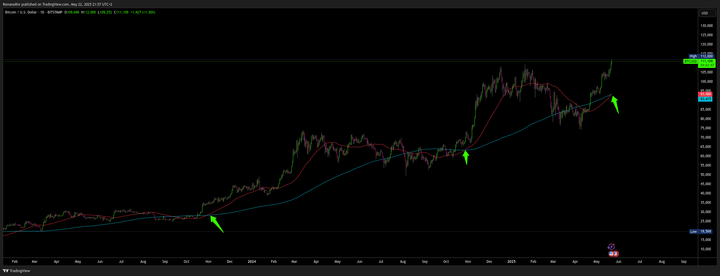Market newsletter Jan 30 - 2023
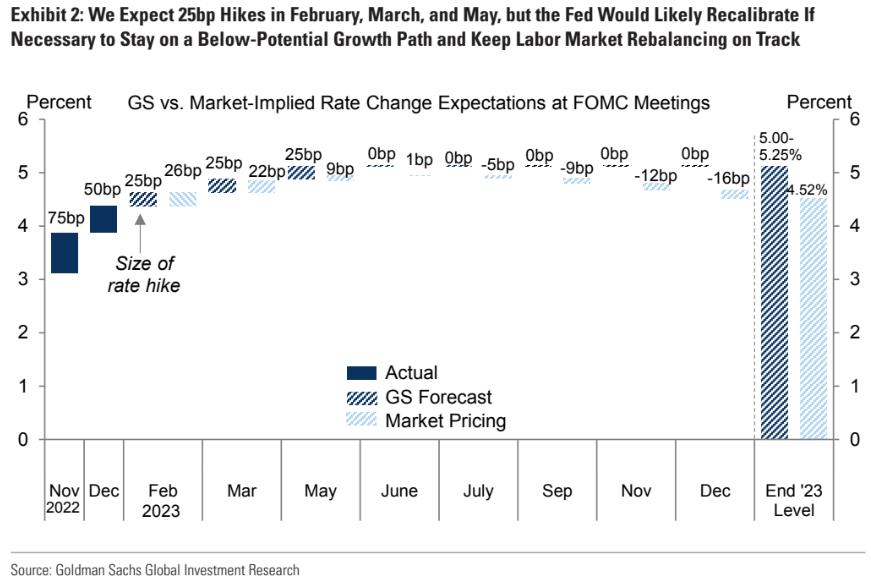
As the Federal Reserve's Open Market Committee (FOMC) moves closer to its rate-hiking cycle, they will likely hike rates by another 25 basis points instead of their past aggressive 50 & 75 bps.
The Federal Reserve won't signal the end of the tightening cycle quite yet to keep inflationary pressure in check.
At this meeting, Jerome Powell will likely explain why the Fed has slowed the pace of its rate hikes and stress the need to be more cautious with the policy stance while maintaining a firm determination to combat inflation.
So, the Fed is nearing its peak rate, and the FOMC is not expected to announce the end of the tightening cycle just yet. At the press conference, I expect the word "ongoing increase" to be replaced with "further increase."
Despite the softening wording that indicates future rate hikes, he will likely emphasize that keeping rates "restrictive for some time will be preferable."
What ifs
But if the statement says "further increase" instead of "ongoing increases," that would allow the Fed to adjust based on data, possibly pausing the rate hike at the upcoming meeting. It would suggest that the Fed is re-evaluating its policy stance.
If Jerome Powell suggests that inflation can normalize without a significant hit in labor markets. In other words, the goals of monetary policy can be achieved without reducing unemployment to the degree previously expected.
That can be seen as a dovish shift, meaning the Fed is now taking a more favorable stance to lower interest rates (increased borrowing and investment) and, thus, less likely to lead to a rate hike. This could mean that the economy could reach a "soft landing" with a lower peak rate than previously estimated. Consequently, markets will likely interpret this as a dovish shift and increase the odds of a soft landing with a lower peak rate.
If the next two job reports indicate a decline in job creation, slowing from the current rate of around 100k, the Fed is likely to adopt a stance that current monetary policy is restrictive enough. Job growth would remain above the replacement threshold, which is around 90k. However, the downward trend combined with interest rates being significantly higher than the neutral rate could indicate future declines. On top of that, upcoming revisions to the January employment report might have a more dovish effect.
If the payroll gains (measured by the number of people employed in the US) turn out to be stronger than expected, the FOMC will likely respond by raising by an additional 25 basis points in March. This is to moderate economic growth and inflation to prevent it from growing too quickly.
Similarly, suppose the inflation rate shows signs of re-acceleration over the next two months. In that case, the FOMC may also be motivated to raise interest rates again in March to prevent the cycle of rising rates from ending too early and causing additional inflationary pressures.
Goldman Sachs rate hike expectations
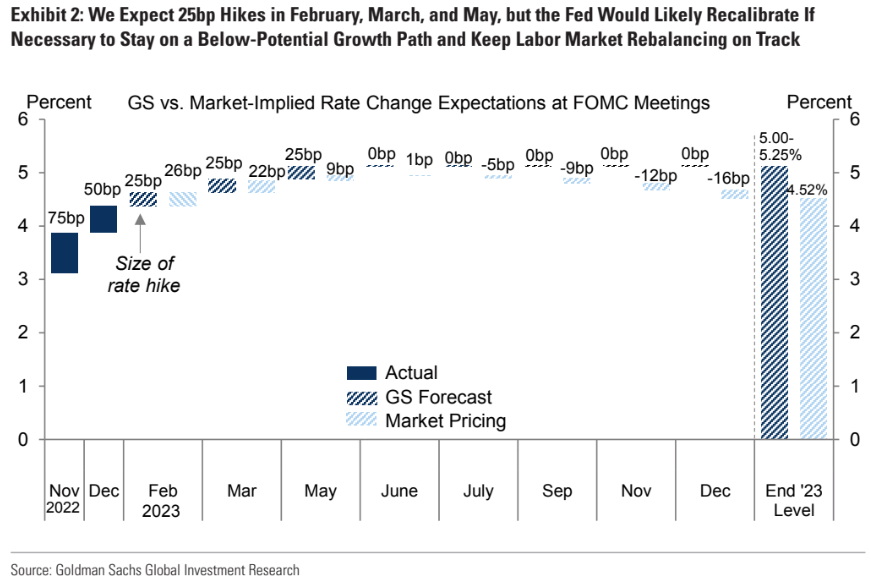
Yield curve strategies - Steepener & Flattener
Steepener
Some strategists at Morgan Stanley have trading strategies targeting the long-term market outlook. These strategies include long 5s, 7s30s Steepeners, and SFRH3H4 Flatteners.
Now that sounds complicated, but I will try to give a quick rundown. 5s, 7s30, and SFRH3H4 are different types of bond investments.
A steepener is a strategy that seeks to capitalize on changes in the yield curve by taking out a "long position" at the short end of the yield curve, which involves buying securities with short-term maturities and a "short position" at the long end of the yield curve, which involves selling securities with long-term maturities.
This strategy takes advantage of the narrowing spread when interest rates rise at the short end of the curve and fall at the long end.
(Little side note: I did not fully complete my study about yield curves)
If the spread between the two is narrow enough, you can have some confidence that the steepening of the yield curve is likely to happen. You can assess the risk & rewards associated with the strategy.
Flattener
A flattener is a strategy that also seeks to capitalize on the changes in the yield curve but, this time, a bit of the opposite compared to the "steepener" strategy. It involves taking out a "long position" at the long end of the yield curve (instead of the short end) with long-term maturities and a "short position" at the "short end" of the yield curve, which involves selling securities with short-term maturities. This strategy makes the yield curve flatter as it takes advantage of the widening spread when interest rates fall at the short end of the curve and rise at the long end of the curve.
So if the spread between the two is wide enough, you can feel confident that the yield curve flattening will likely happen. Furthermore, you can assess the risk & rewards associated.
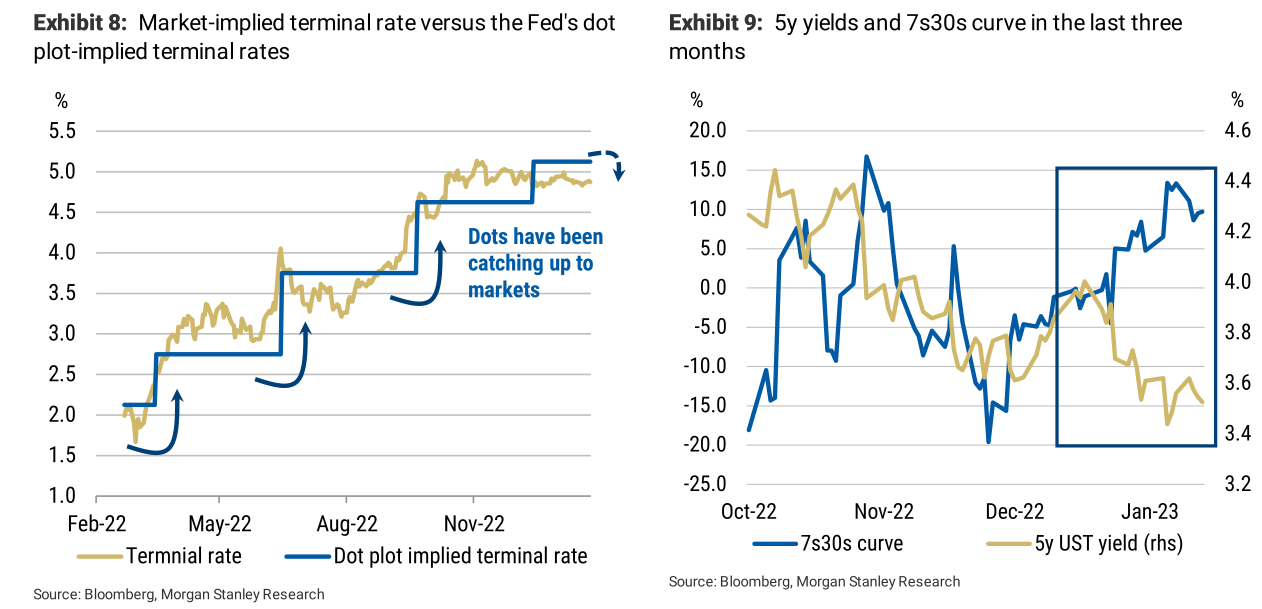
If capitalizing on the curve sounds familiar and you've seen one of my previous writing on medium, then you're right. You might want to check out this article
However yield curves aren't the same, anyways
Interest Rate Strategy
Trade: Long 5y USTs
This interest rate strategy involves taking a long position in 5-year US Treasury securities (USTs). The idea of this strategy is that there is scope for further economic weakness and the possibility that the Federal Reserve may become less hawkish in its monetary policy decisions.
The expectation is that markets will start to price in faster and deeper cuts to interest rates. However, there is some risk that economic growth may rebound with inflation staying high.
In this trade, taking a long position in the USTs, meaning they would be buying USTs from the market in hopes that the price of the USTs will go up in the future. This position would be taken if you believe that markets will start pricing in faster and deeper cuts to interest rates and so driving up the value of USTs. However, that's based on the assumption that there is scope for further economic weakness, and the Fed will become less hawkish in its monetary policy decisions.
There is a risk that economic growth could rebound and inflation could remain high, meaning that the value of the USTs may not increase as anticipated.
7s30s UST steepeners
This interest rate strategy involves taking a position in a 7s30s UST steepener. This type of trade involves taking a long position in 7-year US Treasury securities (USTs) and a short position in 30-year USTs.
The rationale for this strategy is that there is scope for further economic weakness and the possibility that the Federal Reserve may become less hawkish in its monetary policy decisions. The expectation is that markets will start to price in faster and deeper cuts to interest rates. However, there is some risk that economic growth may rebound with inflation staying high.
In this trade, the investor would take a long position in the 7-year USTs and a short position in the 30-year USTs.
This position makes sense if we believe that markets will start pricing in faster and deeper cuts to interest rates. This should cause a steepening of the yield curve, meaning that the spread between the 7-year and 30-year USTs should widen as the price of the 7-year USTs increases and the price of the 30-year USTs decreases.
This is based on the assumption that there is scope for further economic weakness and that the Fed will become less hawkish in its monetary policy decisions. However, there is a risk that economic growth could rebound and inflation could remain high, meaning that the spread between the 7-year and 30-year USTs may not widen as anticipated.
SFRH3H4 flattener
This interest rate strategy involves taking a position in an SFRH3H4 flattener. This type of trade involves taking a long position in 3-month Swiss franc repurchase agreements (SFRs) and a short position in 4-month SFRs.
The rationale for this strategy is that the markets will likely continue to price in deeper and earlier cuts from the Federal Reserve as it remains restrictive with its monetary policy decisions. The expectation is that the spread between the 3-month and 4-month SFRs will become narrower.
However, there is some risk that market expectations for growth could increase significantly, and the odds of a soft landing could continue to increase, meaning that the spread between 3-month and 4-month SFRs may not narrow as anticipated.

Premium subscription
Tired of seeing low-effort content on Twitter with random people posting lines on a chart?
Maybe subscribing to this newsletter is something for you to gain an edge over the market.
Read this content, and give your wife the impression that you actually know what you're reading instead of being a compulsive gambler using "Technical Analysis" (Astrology for men) only.
Also, read my free medium articles: https://medium.com/@romanornr/
Full access to exclusive premium content
Subscribe, and get a competitive edge over the market.
Take the first step to kick your wife's boyfriend out of the house & stop getting liquidated.
Dollar outlook & Forex trades
Recent FOMC speakers have indicated that the Federal Reserve's monetary policy may be having the intended effect of reducing inflationary pressures.
Governor Waller and Vice Chair Brainard discussed unwinding non-wage factors to reduce non-housing services inflation. Additionally, research from the Chicago Fed has suggested that a steeper Phillips curve could result in a lower “sacrifice ratio,” meaning a relatively small rise in the unemployment rate can lead to a large drop in inflation.
That might lead to a shift in market pricing, implying the Federal Reserve's policies return to a neutral stance, or even lower, by the end of 2024. That would put downward pressure on the US dollar. So it makes sense that the decline of the US dollar is in the medium term.
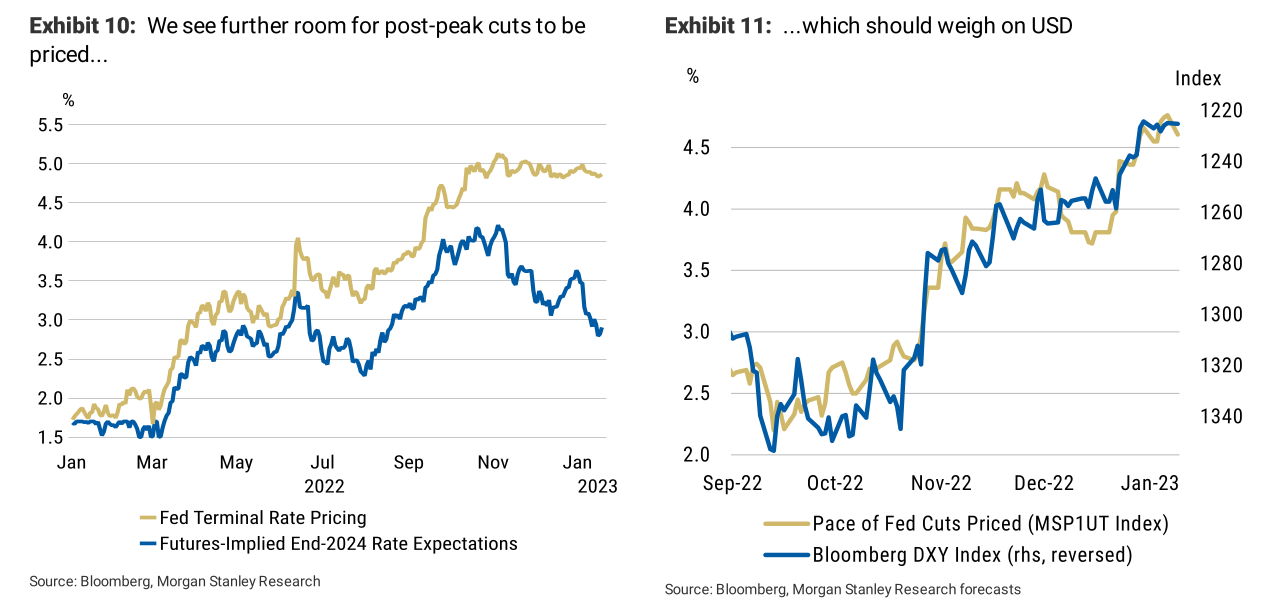
Forex Strategy Trading ideas
Long EURUSD
Take a long position in the EUR/USD currency pair. The rationale is that a combination of dropping European gas costs, a hawkish European Central Bank, a stronger global outlook, and capital repatriation should strengthen the EUR. It is anticipated that the EUR will strengthen against the USD.
However, there is some risk that European gas prices could unexpectedly spike, which could weigh on consumer spending and trigger concerns about stagflation, thus causing the EUR to fall relative to the dollar.
Long NZD/USD
The rationale for this trade is that strong local data, the reopening of China’s economy, and an improving global outlook relative to expectations suggest that the NZD/USD should gain. The expectation is that the NZD will strengthen relative to the USD.
However, there is some risk that US inflation could unexpectedly rebound, leading to broad USD strength and a weakening risk appetite, thus this trade going against us.
Short USD/CAD
The rationale for this trade is that the Canadian dollar (CAD) should advance against the US dollar (USD) as global growth expectations rise, inflation eases in the US and abroad, and China takes measures to ease activity restrictions.
Rising oil prices should also put downward pressure on USD/CAD. The expectation is that the CAD will strengthen relative to the USD.
However, there is some risk that inflation could re-accelerate in core markets, boosting Fed policy expectations and supporting the USD, thus causing the CAD to depreciate relative to the USD.
SPX's notional value in options is over $1 trillion
Goldman Sachs' Garret has reported that the 50-day average notional value traded in SPX options is above $1 trillion.
So on average, over the past 50 days, the notional value traded in SPX options is greater than one trillion dollars. This is an incredibly high number and demonstrates the high level of engagement in the SPX options market.
Such high trading activity can be due to a combination of high volatility, market uncertainty, and investor hedging, as well as institutional and individual investors looking to take advantage of potential market opportunities.
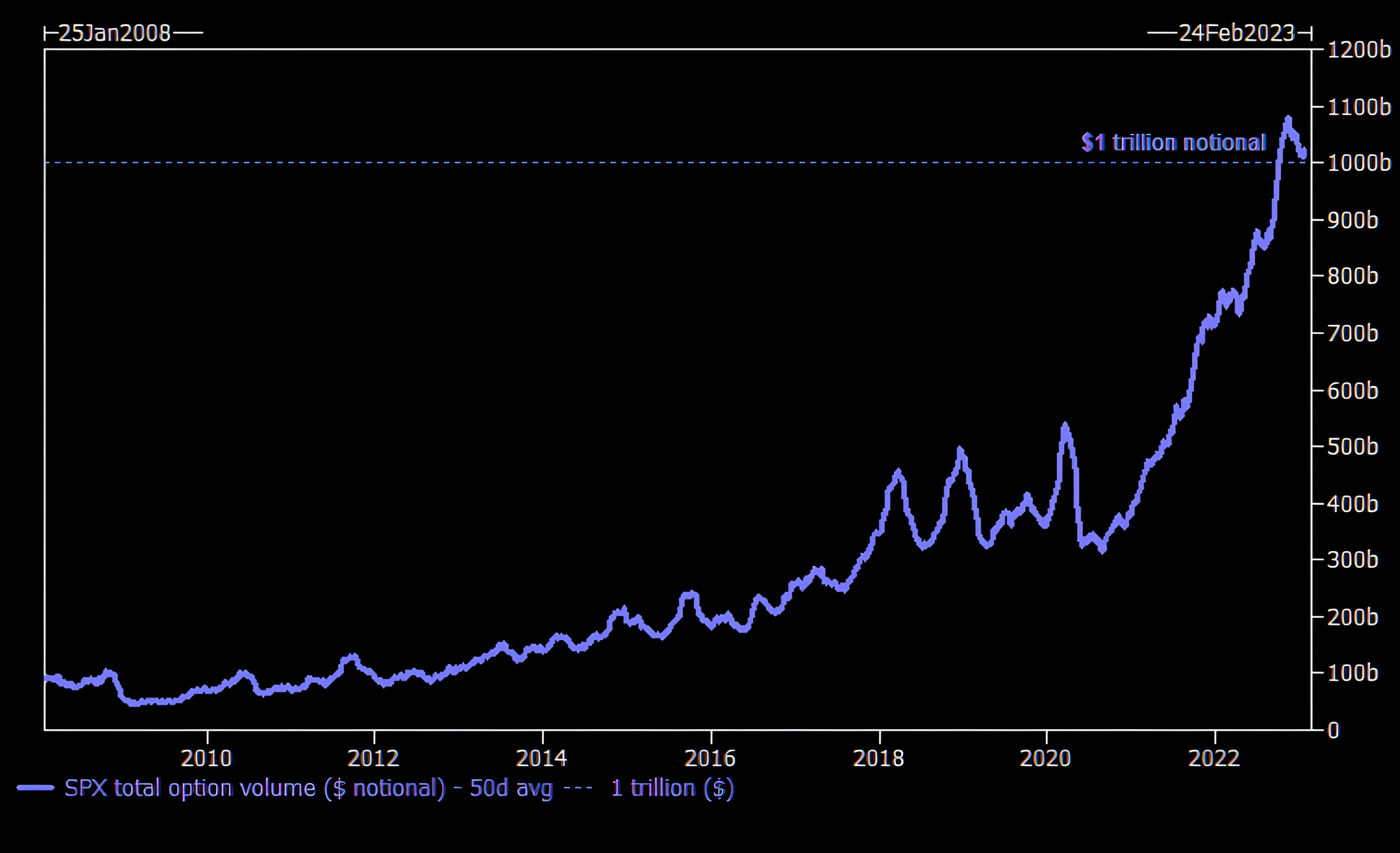
Dumb Money Confidence
This represents the confidence level investors with no expertise have in the stock market.
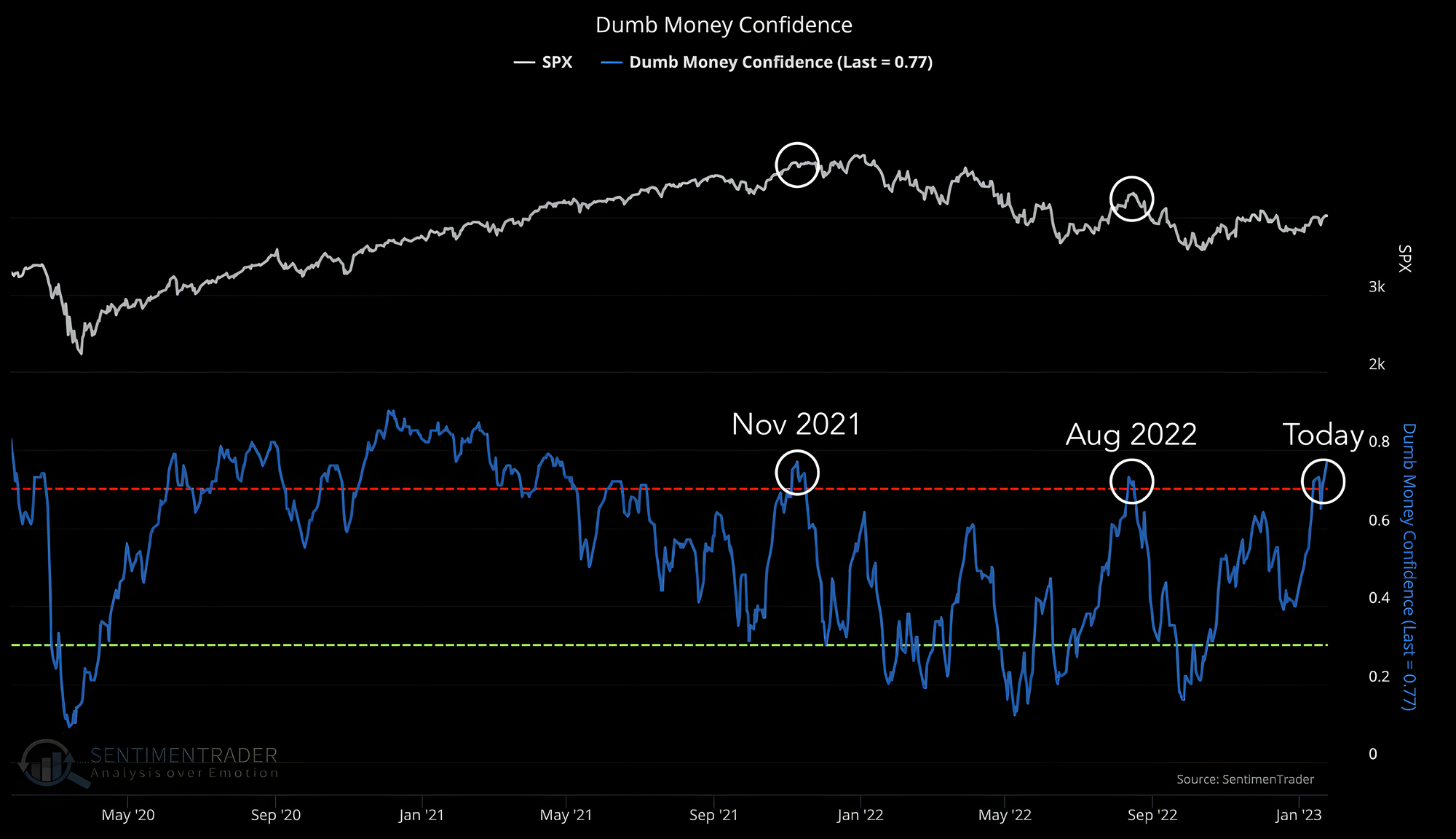
JP Morgan's momentum uptick for Bitcoin
JP Morgan Bitcoin momentum signal z-score of their trend following strategy
JPM's BTC momentum signal is an analysis used by the investment bank JP Morgan to measure the strength of Bitcoin's momentum. It is based on a trend-following strategy, which tracks the changes in the price of Bitcoin to determine whether it is heading in a positive or negative direction.
The signal incorporates a z-score, which measures how far the current Bitcoin price is from its average. A higher z-score indicates that the momentum of Bitcoin is more positive, suggesting that it could be heading in an upwards direction.
By tracking the z-score of the signal, we can gain insight into the price movements of Bitcoin. In this case, the signal has seen an uptick, indicating a strong momentum for Bitcoin.
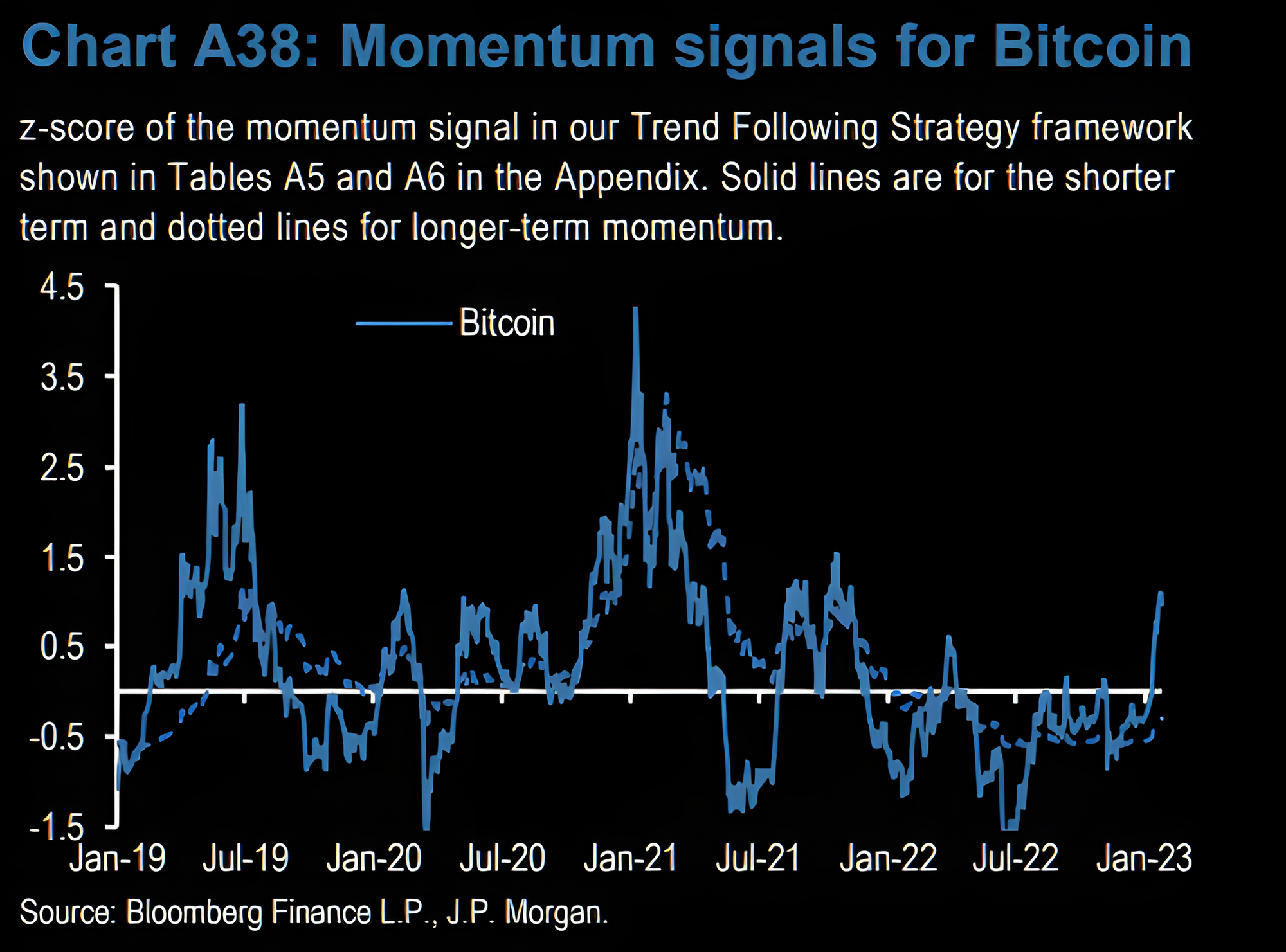
SPX500 Take profit/Fade target
Please read the previous post: https://www.romanornr.io/market-research-jan-25-2023/
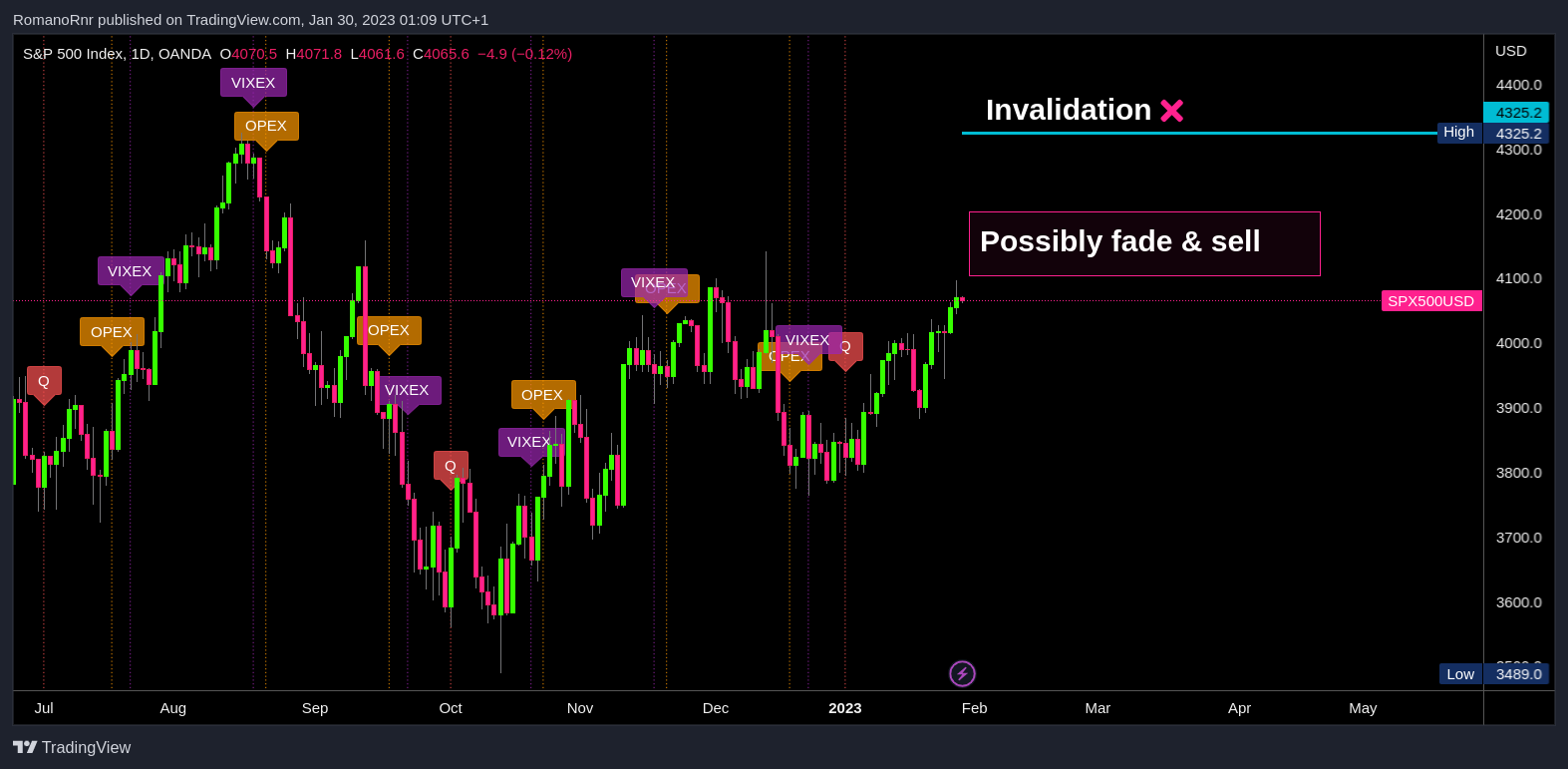
Recession expectation peak
The level of fear among investors over a possible economic recession has risen to a new high. Much as in 2009 and 2020, I will leave it up to you how to interpret this, and there's still a lag effect. Those aggressive rate hikes still have to be felt within the economy, but the effect of these rate hikes is lagging.
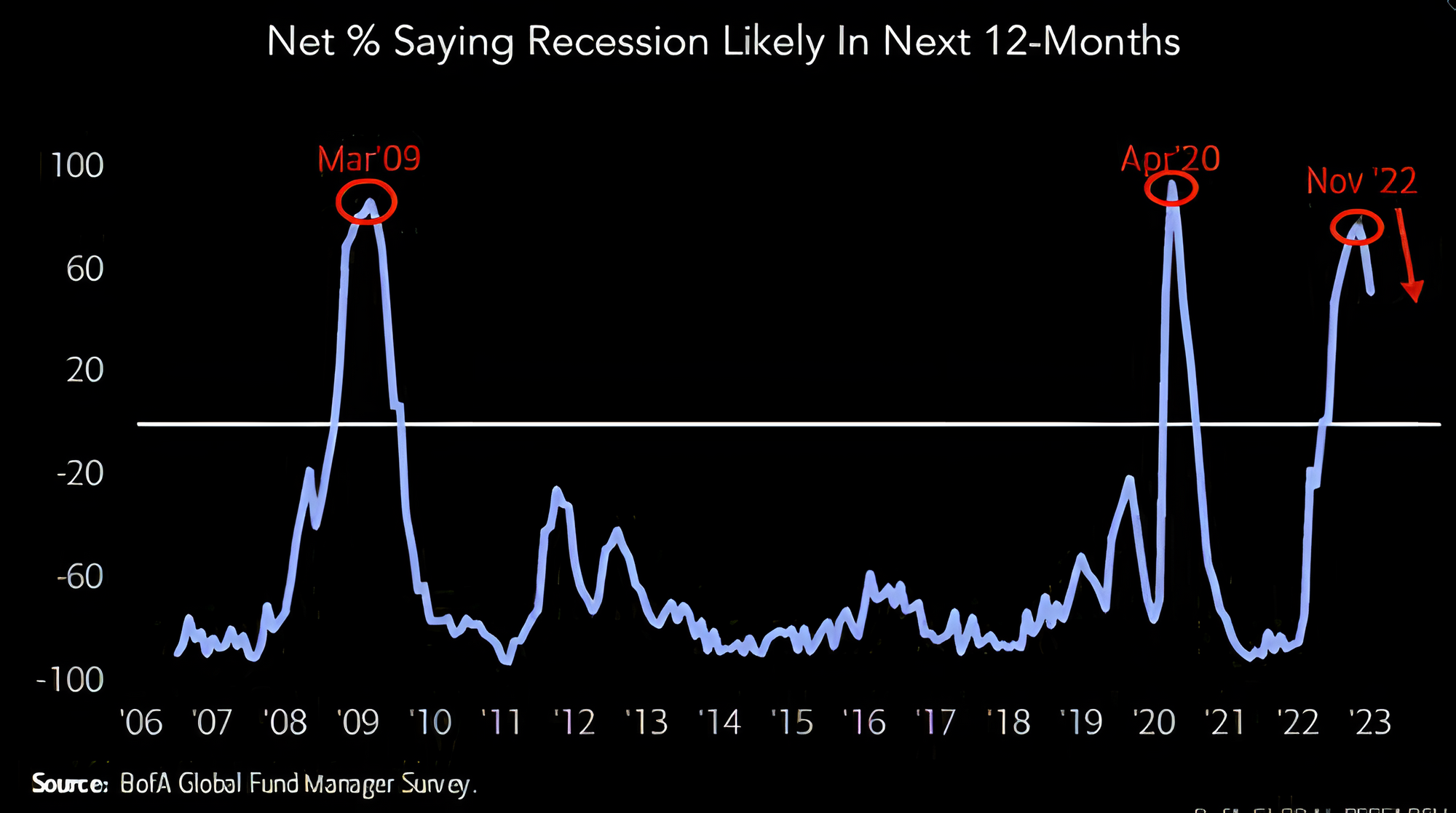
Filecoin airdrop
The Filecoin EVM chain is a powerful network that is currently underutilized. To start using the network, CollectifDAO is a great option.
It's a liquid staking protocol that serves a dual purpose - it operates as both the Filecoin testnet and a platform for issuing Liquid Staking Derivatives (LSDs).
Liquid Staking Derivatives (LSDs) are a type of financial instrument that allows users to benefit from cryptocurrency ownership without holding the underlying token. This is done by taking out collateralized loans where the underlying asset is used as collateral.
They can be used for hedging and speculation to gain exposure to the cryptocurrency market without holding the coins themselves. LSDs have become increasingly popular in the decentralized finance (DeFi) space as they offer a way to maximize profits while minimizing risk.
Visit: https://app.collectif.finance/
Add: https://chainlist.org/chain/3141
Testnet filecoins: https://hyperspace.yoga/#faucet (put in address)
Stake 5 FIL for clFIL
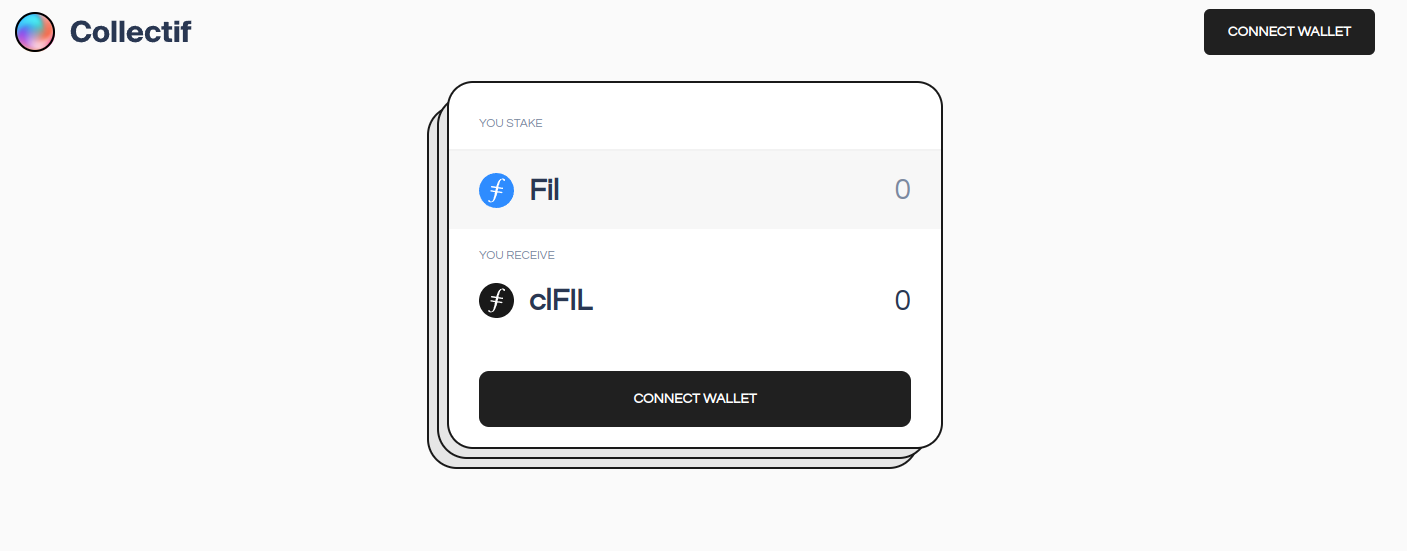
Scroll airdrop
Scroll is a testnet that uses zero-knowledge proofs, like the networks employed by zkSync and StarkNet.
You can get some test funds from the Faucet tab, bridge funds between networks with the Bridge tab, and swap some funds via the Swap tab.
Scroll is actually two separate networks, so you will need to get funds for both networks separately or use the bridge to transfer funds from one network to the other.
It's a bit confusing, but here's a video I made that might help
Blockwallet
I've been recommending Blockwallet in several tweets.
I made the switch from Metamask to Blockwallet.
The user interface and functions are much better; it works better with my Trezor and switching between accounts. Extra privacy, flash bot protection & anti-phishing. You can also import your Metamask seed, etc.
However, I've seen one of their latest tweets, BlockWallet has a token called "BLANK"
Kicking off the new year with some heat - the $BLANK token burn 🔥 pic.twitter.com/rm83xOo0wt
— BlockWallet 🔲 (@GetBlockWallet) January 16, 2023
If I were a betting man, which I am. I will assume that Blockwallet users are eligible for a nice airdrop. I would recommend installing Blockwallet and making some transactions.
You can export your Metamask seed and import it into Blockwallet. There's no need to reshuffle your assets etc., as some people think. Some people don't want to make the switch because Blockwallet has no mobile app right now. It doesn't matter. You can install Metamask or 1inch wallet on your phone and import your seed on your mobile wallet, which is not Blockwallet.

Chrome extension link: https://chrome.google.com/webstore/detail/blockwallet/bopcbmipnjdcdfflfgjdgdjejmgpoaab
Gtrade
I've noticed this interesting DEX. So gTrade has a really nice UI but also has forex and stocks. I am still playing with the DEX. I recommend using the Polygon network to trade on the.
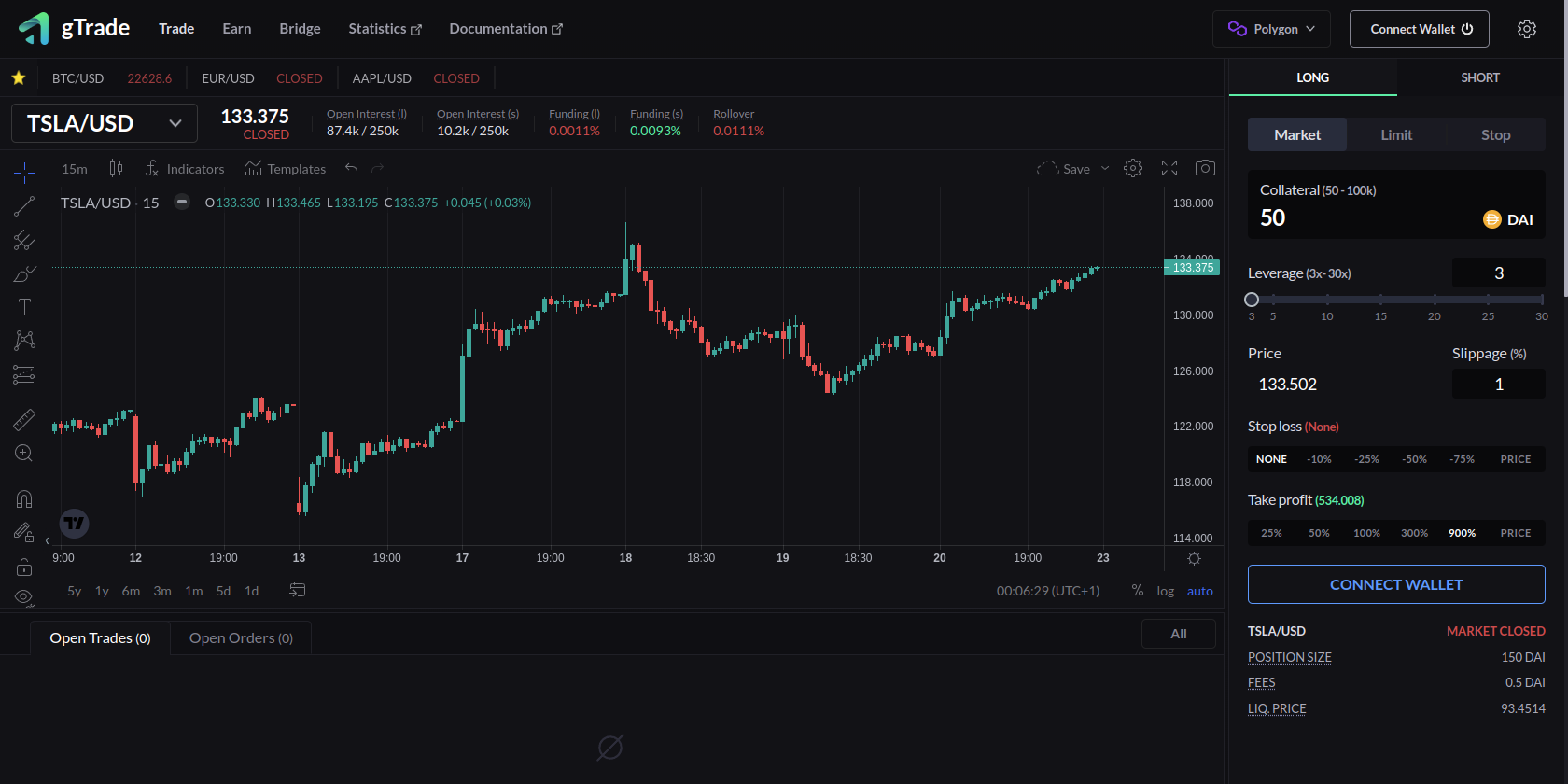

Again, switching from network and bridging is easy with blockwallet
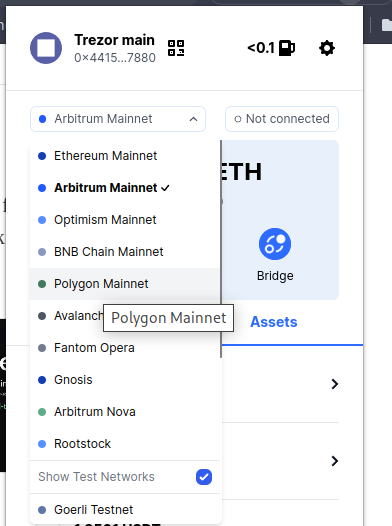
Apex Dex by ByBit
Reminder Apex incentive program, which pays you to trade and keep tour trade open, is ongoing.
They pay rewards to keep that position open lmao
— Romano (@RNR_0) January 12, 2023
Grand idea (however, maybe it won't work)
Use 1 wallet to long x amount
Use 1 wallet to short same amount
Farm rewards neutral?
Discount ref link code: https://t.co/JsJlHH5k3s
Ref code = 46
disclaimer: I hold 1 ApeX OG NFT pic.twitter.com/SgtbrREWS6
Think I can close it for a moment now
— Romano (@RNR_0) January 16, 2023
I like trading on Apex. I get rewards in BANA tokens as a reward
Basically, 1/3 position size as a reward/incentive to trade@OfficialApeXdex is a DEX from ByBit
Interface identical
Can recommend trying out https://t.co/JsJlHH5RT0 pic.twitter.com/Le0Y0y8X9d
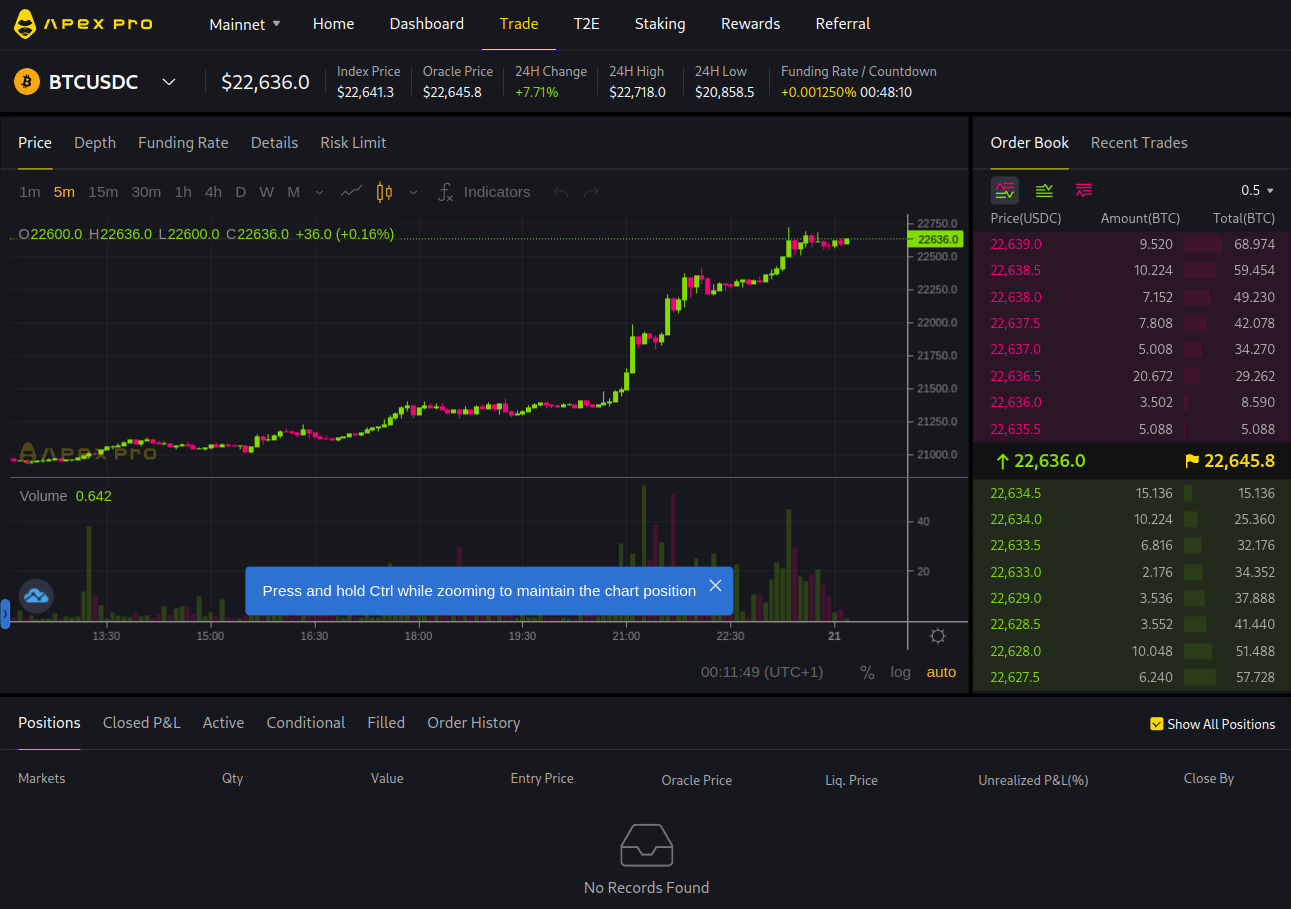
If you need a referral link: https://pro.apex.exchange/trade/BTC-USDC/register?affiliate_id=46&group_id=83
My referral code is: 46
In my opinion, this is the best DEX for trading bitcoin futures.
They also have a mobile app, Android:
Also, an app for iPhone

Ref code = 46
Become an affiliate of this newsletter
Receive 50% of the recurring commission every month
Basically, you get a revenue split, which seems fair to me, as compensation for promoting/sharing the newsletter with others.
Payouts can be in crypto or through bank

Newsletter affiliate
Receive 50% of the recurring commission every month
Basically, you get a revenue split, which seems fair to me as compensation for promoting/sharing the newsletter with others.

